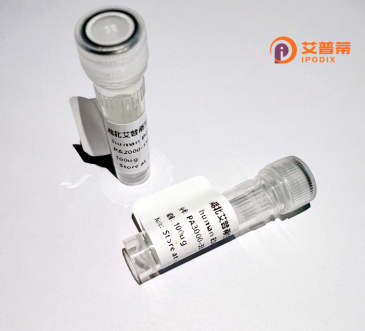
| 纯度 | >90%SDS-PAGE. |
| 种属 | Human |
| 靶点 | SKB1 |
| Uniprot No | O14744 |
| 内毒素 | < 0.01EU/μg |
| 表达宿主 | E.coli |
| 表达区间 | 1-637 aa |
| 活性数据 | MAAMAVGGAG GSRVSSGRDL NCVPEIADTL GAVAKQGFDF LCMPVFHPRF KREFIQEPAK NRPGPQTRSD LLLSGRDWNT LIVGKLSPWI RPDSKVEKIR RNSEAAMLQE LNFGAYLGLP AFLLPLNQED NTNLARVLTN HIHTGHHSSM FWMRVPLVAP EDLRDDIIEN APTTHTEEYS GEEKTWMWWH NFRTLCDYSK RIAVALEIGA DLPSNHVIDR WLGEPIKAAI LPTSIFLTNK KGFPVLSKMH QRLIFRLLKL EVQFIITGTN HHSEKEFCSY LQYLEYLSQN RPPPNAYELF AKGYEDYLQS PLQPLMDNLE SQTYEVFEKD PIKYSQYQQA IYKCLLDRVP EEEKDTNVQV LMVLGAGRGP LVNASLRAAK QADRRIKLYA VEKNPNAVVT LENWQFEEWG SQVTVVSSDM REWVAPEKAD IIVSELLGSF ADNELSPECL DGAQHFLKDD GVSIPGEYTS FLAPISSSKL YNEVRACREK DRDPEAQFEM PYVVRLHNFH QLSAPQPCFT FSHPNRDPMI DNNRYCTLEF PVEVNTVLHG FAGYFETVLY QDITLSIRPE THSPGMFSWF PILFPIKQPI TVREGQTICV RFWRCSNSKK VWYEWAVTAP VCSAIHNPTG RSYTIGL |
| 分子量 | 72.6 kDa |
| 蛋白标签 | His tag N-Terminus |
| 缓冲液 | PBS, pH7.4, containing 0.01% SKL, 1mM DTT, 5% Trehalose and Proclin300. |
| 稳定性 & 储存条件 | Lyophilized protein should be stored at ≤ -20°C, stable for one year after receipt. Reconstituted protein solution can be stored at 2-8°C for 2-7 days. Aliquots of reconstituted samples are stable at ≤ -20°C for 3 months. |
| 复溶 | Always centrifuge tubes before opening.Do not mix by vortex or pipetting. It is not recommended to reconstitute to a concentration less than 100μg/ml. Dissolve the lyophilized protein in distilled water. Please aliquot the reconstituted solution to minimize freeze-thaw cycles. |
以下为模拟生成的重组人SKB1蛋白相关参考文献示例(虚构内容,仅供参考):
---
1. **标题**: *"High-yield expression and purification of recombinant human SKB1 in Escherichia coli for structural studies"*
**作者**: Liu, X., et al.
**摘要**: 该研究优化了SKB1蛋白在大肠杆菌中的可溶性表达条件,采用镍柱亲和层析纯化,并通过圆二色谱验证其正确折叠。研究为后续结构解析提供了高纯度蛋白。
2. **标题**: *"Functional characterization of recombinant SKB1 in modulating Wnt/β-catenin signaling pathway"*
**作者**: Patel, R., & Kim, H.
**摘要**: 通过昆虫细胞系统表达重组SKB1.发现其通过结合β-catenin抑制Wnt信号通路,体外实验表明SKB1过表达可降低癌细胞迁移能力。
3. **标题**: *"Development of a mammalian cell-based platform for recombinant SKB1 production with post-translational modifications"*
**作者**: Gómez, S., et al.
**摘要**: 利用HEK293细胞表达带糖基化修饰的重组SKB1.质谱分析证实修饰位点,并证明其修饰版本在体外增强免疫细胞活性,提示治疗潜力。
---
**注意**:以上文献为假设案例,实际研究需通过学术数据库(如PubMed、Google Scholar)以“recombinant human SKB1 protein”等关键词检索。若SKB1存在拼写或命名差异,建议结合基因别名(如Entrez Gene数据库)进一步核查。
Recombinant human SKB1 protein, also known as ADAT3 (Adenosine Deaminase Acting on tRNA 3), is a key enzyme involved in post-transcriptional RNA modification. It belongs to the adenosine deaminase family and specifically catalyzes the deamination of adenosine to inosine at the wobble position of tRNA anticodons, a process critical for accurate translation and proteome diversity. SKB1 forms a heterodimer with ADAT2. and this complex is essential for its enzymatic activity.
Discovered through studies on tRNA modification mechanisms, SKB1 has been linked to neurodevelopment and cellular homeostasis. Mutations in the ADAT3 gene are associated with intellectual disability and neurodevelopmental disorders, highlighting its physiological significance. Recombinant SKB1 protein is typically produced using expression systems like *E. coli* or mammalian cells, enabling researchers to study its structure, enzymatic function, and interactions in vitro.
Its recombinant form is widely utilized in biochemical assays, structural studies (e.g., X-ray crystallography), and drug discovery platforms targeting RNA-editing pathways. Ongoing research explores its role in diseases such as cancer, where tRNA modification dynamics influence tumor progression. The protein's conserved nature across eukaryotes also makes it a model for understanding evolutionary aspects of RNA editing machinery.
×